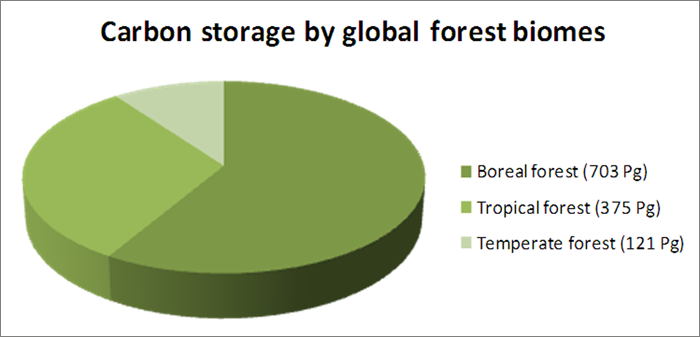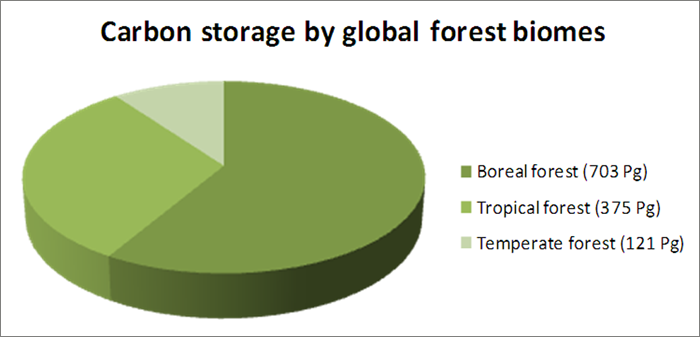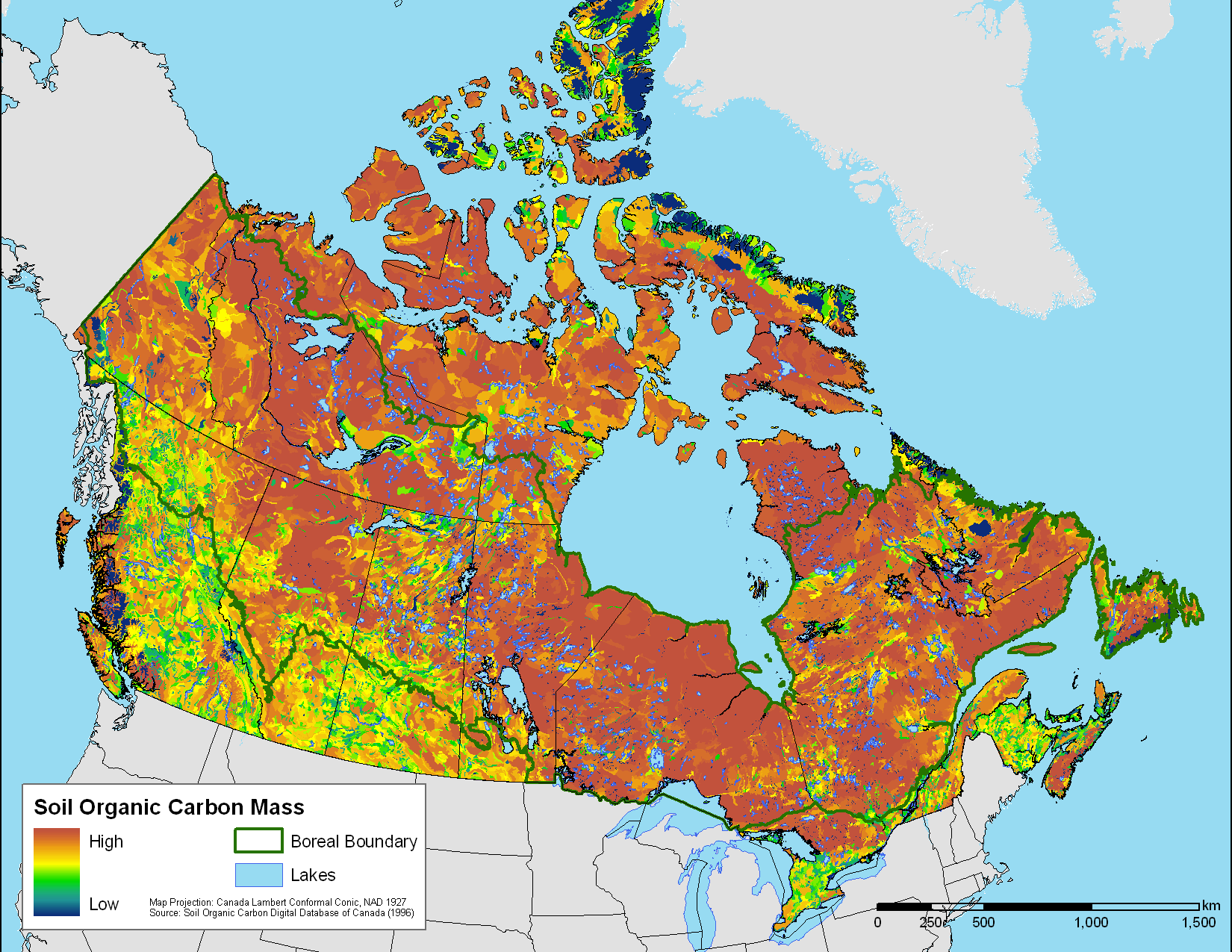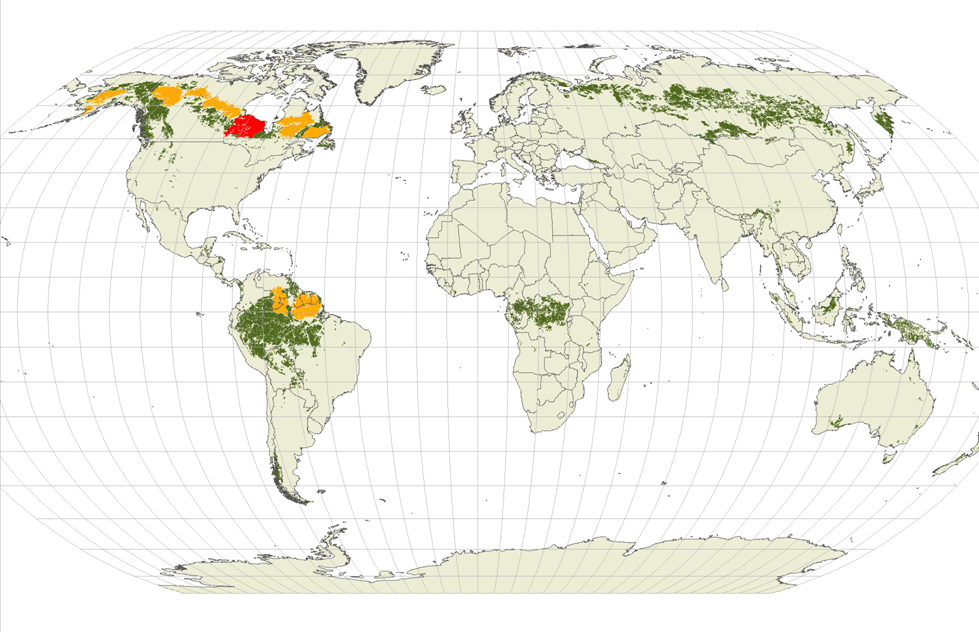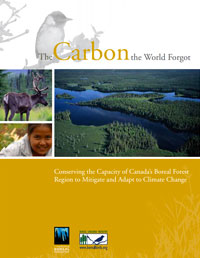Announcements
The Carbon the World Forgot
Boreal forests store more carbon than any other terrestrial ecosystem on earth – twice as much per area as tropical forests. Past estimates of this carbon greatly underestimated the amount, depth, and longevity of this carbon. As the most intact remaining forest on earth, the boreal forest also has exceptionally high potential to accommodate plants and animals forced to shift due to climate change.
This report questions whether international negotiations on carbon and forest protection have adequately considered boreal forests in light of the scientific findings outlining their significance.
Full Report in English »
Full Report in French »
Order Printed Copy of the Report »
December 14, 2009:
Nineteen prominent international scientists, including several members of the Nobel Prize-winning IPCC, send letter to the heads of state of all eight boreal forest nations.
Letter calls on leaders to recognize the importance of boreal forests as a carbon storehouse and haven for species adaptation, urge swift measures for protection.
Highlighted Media Articles
Canada sets aside its boreal forest as giant carbon vault, Guardian (UK), 10/29/09.
Group Urges Protection of Northern Forests, New York Times, 11/12/09.
Boreal forests store carbon,need help-Canada study, Reuters, 11/12/09.
Boreal forests ignored in climate change fight, CBC News, 11/12/09.
Canada's boreal forest top-rated carbon warehouse, Vancouver Sun, 11/12/09.
Correspondence: Boreal forests' carbon stores need better management, Nature, 11/19/09.
Expert Contacts for Interviews
Steve Kallick, Director, International Boreal Conservation Campaign, Pew Environment Group
206-327-1184, skallick@pewtrusts.org
Dr. Jeff Wells, Report author and Director of Science and Policy, Boreal Songbird Initiative,
207-458-8492, jeffw@borealbirds.org
Larry Innes, Executive Director, Canadian Boreal Initiative,
416-575-6776, 613-230-4739 ext 226, linnes@borealcanada.ca
For further information and assistance contact:
Sue Libenson, Media Director, International Boreal Conservation Campaign, 907-766-2841, sue@interboreal.org or Suzanne Fraser, Director of Communications, Canadian Boreal Initiative, (613) 232‐2530, sfraser@borealcanada.ca
Interviews can also be arranged with report reviewers Dr. Stuart Pimm, leading conservation biologist and tropical forest advocate, Duke University and Dr. Andrew Weaver, lead author for the United Nations' Intergovernmental Panel on Climate Change which was awarded the Nobel Prize, University of Victoria.
Key Findings Q&A
What are new findings regarding the significance of carbon stored in the boreal forest?
Recent studies find that previous global accounting of carbon had vastly underestimated the amount, depth, and age of carbon stored in the boreal forest.1 In fact, much of the world's terrestrial carbon is stored in boreal forest soil and peatlands, making it the world's largest and most important terrestrial carbon storehouse.2
Boreal forest carbon is stored in both trees and in underlying peat and soils. The boreal forest "carbon bank" stores 22 percent of all carbon stored on the earth's land surface.3
Canada hosts most of North America's Boreal Forest. Canada's vast Boreal Forest stores an estimated 208 billion tons of carbon (71 billion tons in forests4 and 137 billion tons in peatlands5)—the equivalent of 26 years worth of global carbon emissions from burning fossil fuels.6
How does the boreal forest store carbon differently from tropical forests?
Boreal forests store almost twice as much carbon per area as tropical forests.7 New studies examining the depth of carbon stored in boreal soils indicate that this factor may be much larger.
While the majority of carbon in tropical forests is stored in above-ground vegetation, boreal forests build up large below-ground carbon deposits through deep peatlands and permafrost soils. Thus, the high carbon density of the boreal forest region has resulted from the slow accumulation of carbon over millennia.8
Carbon flux in tropical forests is balanced between plant growth and decay, whereas cool temperatures of boreal ecosystems prevent the breakdown of dead biomass, leading to large accumulations of carbon over thousands of years.9 Boreal peatlands behave more like terrestrial oceans, sequestering carbon and keeping it out of the atmosphere for 6,000-8,000 years.
What role does boreal forest carbon play in climate change?
Boreal forests and peatlands have a net cooling effect on the climate due to their ability to remove atmospheric CO2 and store it underground for thousands of years.10 However, when boreal forests are logged or soils are disturbed, carbon and methane greenhouse gasses are released, accelerating global warming.11 Because the boreal forest is the largest terrestrial carbon storehouse on earth, keeping the boreal carbon reservoir in place is essential to avoid accelerating climate change.
Why is this climate change different than all other climate changes?
Unlike past periods of climate change, most habitats today are highly fragmented and degraded by human activity, creating a variety of additional obstacles for species migration and survival. In most parts of the world, wildlife populations are also severely reduced, further limiting their capacity to adapt to climate change.12
The current rate of climate change is also unprecedented and fastest in the north, adding urgency to the need to maintain intact boreal habitats. Average temperatures in northern Canada are predicted to rise 4-5C over the next 100 years13 as opposed to 3C on average for the globe.14
What role does the boreal forest, the world's most intact remaining forest, play in climate adaptation and biodiversity?
Habitat intactness and the abundance of many wildlife populations combine to give the boreal forest an unrivaled opportunity to protect biodiversity and avoid species extinctions in the face of climate change.15 The Boreal Forest contains the world's largest, most intact remaining forest and peatland complexes. Canada's Boreal Forest region still hosts abundant resident and migratory wildlife, including billions of migratory birds,16 the world's largest caribou herds, and healthy populations of large carnivores.
Top Intact Forests - largest in red, followed by yellow and green, representing forests undisturbed to date by humans
Intact forests better allow for shifts in the distributions of plants and animals.17 Large, unfragmented, connected habitats better allow species to shift or migrate to different forest regions if necessary. The vast boreal forest is also intact across climate gradients, providing further opportunities for shifting species in need of adapting to climate changes.18
What policies are scientifically recommended for boreal forest conservation?
Over 1,500 international scientists led by Nobel Prize winning authors for the United Nations' Intergovernmental Panel on Climate Change have recommended that at least half of Canada's Boreal Forest be protected from any further disturbance.19
The high carbon content and intactness of boreal ecosystems point toward conservation of boreal forests and peatlands as being effective for achieving the co-benefits of climate change mitigation and adaptation.
How are scientific recommendations for Boreal Forest conservation reflected in international protocol or legislation?
Policies have yet to match the scientific understanding of the boreal forest's importance for carbon storage, climate change adaptation, and biodiversity.
To date, the spotlight has largely been on tropical forests. Somewhere on the order of 20% of man-made greenhouse gas emissions are related to land use changes such as deforestation.20 Currently, the majority of those forest related emissions occur in tropical countries. However, the overall quantity of carbon stored in the boreal forest is greater, so preventative measures to protect that carbon in place are critical in the fight against global warming.
The Kyoto Protocol failed to create sufficient incentives for forest conservation and sustainable forestry. Carbon accounting for peatlands, the planet's most carbon-rich ecosystems, was also not included.
Future climate change protocols must be better suited to motivate stewardship of the massive quantity of carbon stored in forest and peatland ecosystems.
Two simple changes to the protocol that would have far-reaching beneficial impacts are 1) inclusion of peatland carbon; and 2) mandatory accounting of all carbon emissions from forest management, without an obligation to account for emissions caused by natural disturbances. This protocol should also require a positive or neutral affect on biodiversity and ecosystem services in order to maintain capacity to adapt.
1Tarnocai, C., J.G. Canadell, E.A.G. Schuur, P. Kuhry, G. Mazhitova, and S. Zimov. 2009. Soil organic carbon pools in the northern circumpolar permafrost region. Global Biogeochemical Cycles 23, GB2023, doi:10.1029/2008GB003327.
2Kasischke, E.S., Boreal ecosystems in the global carbon cycle, pp. 19-30 in Fire, Climate Change and Carbon Cycling in the Boreal Forest, Kasischke, E.S., and B.J. Stocks (editors), Ecological Studies Series, Springer-Verlag, New York, 2000.
3IPCC (Intergovernmental Panel on Climate Change). 2000. Land Use, Land-Use Change and Forestry. R.T. Watson, I.R. Noble, B. Bolin, N.H. Ravindranath, D.J. Verardo, and D.J. Dokken (eds.). Cambridge University Press, Cambridge, U.K.
4Kurz, W.A., and M.J. Apps. 1999. A 70-year retrospective analysis of carbon fluxes in the Canadian forest sector. Ecol. Appl. 9(2): 526-547.
5Tarnocai, C. 2006. The effect of climate change on carbon in Canadian peatlands. Global and Planetary Change 53(4):222-232.
6Energy Information Administration. 2009. International Energy Outlook 2009. U.S. Department of Energy. (19 October 2009 http://www.eia.doe.gov/oiaf/ieo/emissions.html).
7IPCC (Intergovernmental Panel on Climate Change). 2000. Land Use, Land-Use Change and Forestry. R.T. Watson, I.R. Noble, B. Bolin, N.H. Ravindranath, D.J. Verardo, and D.J. Dokken (eds.). Cambridge University Press, Cambridge, U.K.
8Gorham, E. 1991. Northern peatlands: role in the carbon cycle and probable responses to climatic warming. Ecological Applications 1(2): 182-195.
9Schuur, E.A.G., J. Bockheim, J.G. Canadell, E. Euskirchen, C.B. Field, S.V. Goryachkin, S. Hagemann, P. Kuhry, P.M. Lafleur, H. Lee, G. Mazhitov, F.E. Nelson, A. Rinke, V.E. Romanovsky, N. Shiklomanov, C. Tarnocai, S. Venevsky, J.G. Vogel and S.A. Zimov. 2008. Vulvernability of permafrost carbon to climate change: implications for the global carbon cycle. Bioscience. 58(8): 701-714.
10Dise, N.B 2009. Peatland response to global change. Science 326: 810-811
11IPCC. 2007. Summary for policymakers. In S. Solomon, D. Qin, M. Manning, Z. Chen, M. Marquis, K.B. Averyt, M.Tignor and H.L. Miller (eds.). Climate Change 2007: The Physical Science Basis. Contribution of Working Group I to the Fourth Assessment Report of the Intergovernmental Panel on Climate Change, Cambridge University Press, Cambridge, New York, NY, USA.
12Noss, R.F. 2001. Beyond Kyoto: forest management in a time of rapid climate change. Conservation Biology 15(3): 578-590.
13Christensen, J.H., B. Hewitson, A. Busuioc, A. Chen, X. Gao, I. Held, R. Jones, R.K. Kolli, W.-T. Kwon, R. Laprise, V. Magaña Rueda, L. Mearns, C.G. Menéndez, J. Räisänen, A. Rinke, A. Sarr and P. Whetton, 2007: Regional Climate Projections. In: Climate Change 2007: The Physical Science Basis. Contribution of Working Group I to the Fourth Assessment Report of the Intergovernmental Panel on Climate Change [Solomon, S., D. Qin, M. Manning, Z. Chen, M. Marquis, K.B. Averyt, M. Tignor and H.L. Miller (eds.)]. Cambridge University Press, Cambridge, United Kingdom and New York, NY, USA.
14Meehl, G.A., T.F. Stocker, W.D. Collins, P. Friedlingstein, A.T. Gaye, J.M. Gregory, A. Kitoh, R. Knutti, J.M. Murphy, A. Noda, S.C.B. Raper, I.G. Watterson, A.J. Weaver and Z.-C. Zhao, 2007: Global Climate Projections. In: Climate Change 2007: The Physical Science Basis. Contribution of Working Group I to the Fourth Assessment Report of the Intergovernmental Panel on Climate Change [Solomon, S., D. Qin, M. Manning, Z. Chen, M. Marquis, K.B. Averyt, M. Tignor and H.L. Miller (eds.)]. Cambridge University Press, Cambridge, United Kingdom and New York, NY, USA.
15Ruckstuhl, K.E., E.A. Johnson, and K. Miyanishi. 2008. Introduction: The Boreal Forest and Climate Change. Phil. Trans. R. Society B. 363(1501): 2243-2247.
16Blancher, P. 2003. The Importance of Canada's Boreal Forest to Landbirds. Canadian Boreal Initiative and Boreal Songbird Initiative.
17Innes, J., L.A. Joyce, S. Kellomaki, B. Louman, A. Ogden, J. Parrotta, I. Thompson, M. Ayres, C. Ong, H. Santoso, B. Sohngen, and A. Wreford. 2009. Management for adaptation. Pg 135-186 in: R. Seppala, A. Buck, P. Katila (eds.). Adaptation of Forests and People to Climate Change. A Global Assessment Report. IUFRO World Series Volume 22. Helsinki, Finland.
18Chapin, F.S., K. Danell, T. Elmqvist, C. Folke, and N. Fresco. 2007. Managing climate change impacts to enhance the resilience and sustainability of Fennoscandian Forests. Ambio 36(7): 528-533.
19See: http://www.borealbirds.org/scienceletter.shtml
20IPCC. 2007. Summary for policymakers. In S. Solomon, D. Qin, M. Manning, Z. Chen, M. Marquis, K.B. Averyt, M.Tignor and H.L. Miller (eds.). Climate Change 2007: The Physical Science Basis. Contribution of Working Group I to the Fourth Assessment Report of the Intergovernmental Panel on Climate Change, Cambridge University Press, Cambridge, New York, NY, USA.


